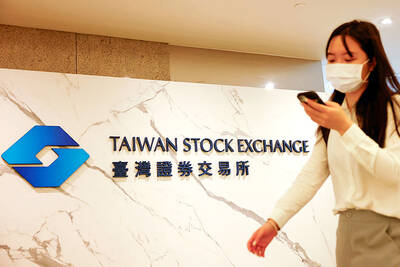The World Bank yesterday raised its forecast for China’s economic growth this year and next, but warned that subdued household and business confidence, along with headwinds in the property sector, would keep weighing it down next year.
The world’s second-biggest economy has struggled this year, mainly due to a property crisis and tepid domestic demand.
An expected hike in US tariffs on its goods when US president-elect Donald Trump takes office next month might also hit growth.

Photo: Reuters
“Addressing challenges in the property sector, strengthening social safety nets, and improving local government finances will be essential to unlocking a sustained recovery,” World Bank country director for China Mara Warwick said in a statement. “It is important to balance short-term support to growth with long-term structural reforms.”
Thanks to the effect of policy easing and near-term export strength, the World Bank sees China’s GDP growth at 4.9 percent this year, up from its June forecast of 4.8 percent.
Beijing set a growth target of about 5 percent this year, a goal that it says it is confident of achieving.
Although growth for next year is also expected to fall to 4.5 percent, that is still higher than the World Bank’s earlier forecast of 4.1 percent.
Slower household income growth and the negative wealth effect from lower house prices are expected to weigh on consumption into next year, the World Bank said, adding that a turnaround in the property sector is not anticipated until late next year.
To revive growth, Chinese authorities have agreed to issue a record 3 trillion yuan (US$411 billion) in special treasury bonds next year, Reuters reported this week.
The figures are not being officially unveiled until the annual meeting of China’s parliament, the National People’s Congress, in March, and could still change before then.
China’s middle class has expanded significantly since the 2010s, encompassing 32 percent of the population in 2021, but World Bank estimates suggest that about 55 percent remain “economically insecure,” underscoring the need to generate opportunities.

ADVANCED: Previously, Taiwanese chip companies were restricted from building overseas fabs with technology less than two generations behind domestic factories Taiwan Semiconductor Manufacturing Co (TSMC, 台積電), a major chip supplier to Nvidia Corp, would no longer be restricted from investing in next-generation 2-nanometer chip production in the US, the Ministry of Economic Affairs said yesterday. However, the ministry added that the world’s biggest contract chipmaker would not be making any reckless decisions, given the weight of its up to US$30 billion investment. To safeguard Taiwan’s chip technology advantages, the government has barred local chipmakers from making chips using more advanced technologies at their overseas factories, in China particularly. Chipmakers were previously only allowed to produce chips using less advanced technologies, specifically

The New Taiwan dollar is on the verge of overtaking the yuan as Asia’s best carry-trade target given its lower risk of interest-rate and currency volatility. A strategy of borrowing the New Taiwan dollar to invest in higher-yielding alternatives has generated the second-highest return over the past month among Asian currencies behind the yuan, based on the Sharpe ratio that measures risk-adjusted relative returns. The New Taiwan dollar may soon replace its Chinese peer as the region’s favored carry trade tool, analysts say, citing Beijing’s efforts to support the yuan that can create wild swings in borrowing costs. In contrast,

VERTICAL INTEGRATION: The US fabless company’s acquisition of the data center manufacturer would not affect market competition, the Fair Trade Commission said The Fair Trade Commission has approved Advanced Micro Devices Inc’s (AMD) bid to fully acquire ZT International Group Inc for US$4.9 billion, saying it would not hamper market competition. As AMD is a fabless company that designs central processing units (CPUs) used in consumer electronics and servers, while ZT is a data center manufacturer, the vertical integration would not affect market competition, the commission said in a statement yesterday. ZT counts hyperscalers such as Microsoft Corp, Amazon.com Inc and Google among its major clients and plays a minor role in deciding the specifications of data centers, given the strong bargaining power of

TARIFF SURGE: The strong performance could be attributed to the growing artificial intelligence device market and mass orders ahead of potential US tariffs, analysts said The combined revenue of companies listed on the Taiwan Stock Exchange and the Taipei Exchange for the whole of last year totaled NT$44.66 trillion (US$1.35 trillion), up 12.8 percent year-on-year and hit a record high, data compiled by investment consulting firm CMoney showed on Saturday. The result came after listed firms reported a 23.92 percent annual increase in combined revenue for last month at NT$4.1 trillion, the second-highest for the month of December on record, and posted a 15.63 percent rise in combined revenue for the December quarter at NT$12.25 billion, the highest quarterly figure ever, the data showed. Analysts attributed the